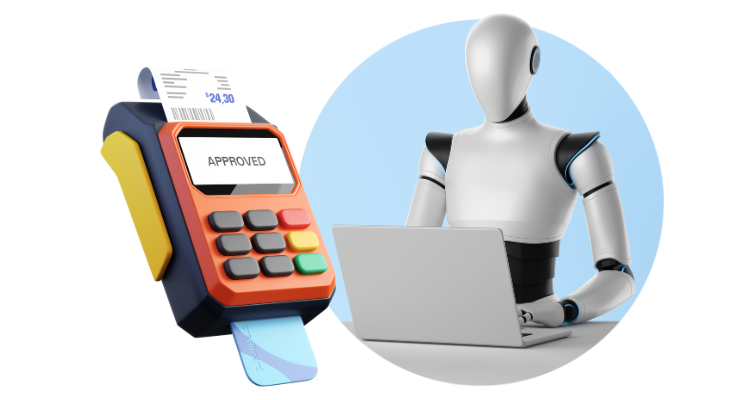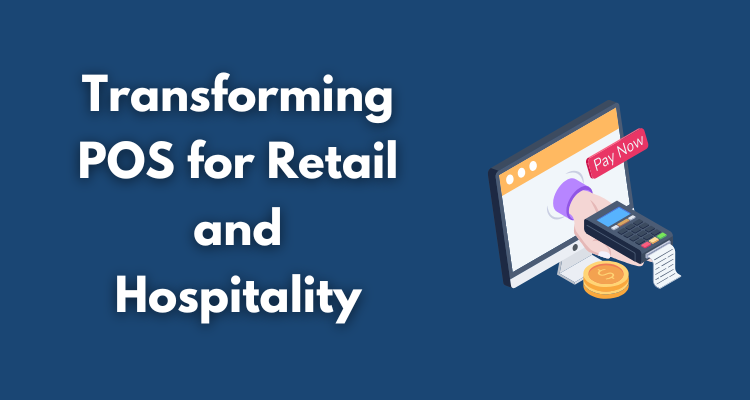Point-of-sale (POS) systems are the core of retail and hospitality transactions, but the traditional models have reached their limits. Today’s consumers expect omnichannel experiences across brick-and-mortar stores, mobile, and online channels.
At the same time, operators are pressured by rising labor costs, fluctuating supply chains, and competitive pricing demands. Legacy POS setups, while reliable for recording transactions, lack the intelligence required to support modern operations.
The market signals are clear. According to Statista, the transaction value in mobile POS payments is projected to reach $12.56 trillion in 2025, with growth expected to double by 2030 to $24.56 trillion. Deloitte’s Global Powers of Retailing 2025 further highlights that leading retailers are investing in AI and automation to optimize inventory, streamline supply chains, and improve customer interactions.
The shift from transactional to intelligent POS systems requires reimagining how businesses serve customers, manage operations, and build long-term resilience.
Table of Contents
ToggleTOP 5 AI Innovation Pillars in POS

AI is no longer a buzzword in retail and hospitality technology, it is becoming the driver of innovation in point-of-sale systems. From predictive analytics to compliance automation, intelligent POS solutions are redefining how businesses handle transactions and customer interactions. Below are the five most practical AI-powered features shaping the next generation of POS.
1. Demand Forecasting
Machine learning enables businesses to anticipate demand shifts with greater accuracy. With AI-driven demand forecasting, businesses cut stockouts by 65% and boost customer retention by 25%.
MobiDev’s work with SmartTab demonstrates that AI-driven demand forecasting can turn years of transactional data into predictive insights, helping restaurants and nightclubs minimize stockouts and allocate resources effectively.
Retailers can also integrate seasonal data, marketing campaigns, or local events into forecasts, aligning supply with real-world demand.
2. Sales Data Analytics
Sales data is a goldmine for strategic decisions when analyzed in real time. AI modules in POS can track performance by product category, highlight anomalies, and optimize pricing strategies.
For example, analytics dashboards can provide operators with daily insights, improving margins and guiding smarter adjustments.
The Home Depot is handling returns through interconnected POS and backend systems, ensuring omnichannel analytics feed directly into decision-making for both sales and customer service.
3. Intelligent Inventory Management
AI-powered inventory management systems can balance supply and demand by automatically triggering re-stocks and flagging anomalies. BarTrack, an IoT solution integrated with POS platforms, demonstrates how sensors and analytics can monitor beverage volumes, temperature, and pressure to reduce waste and improve accuracy.
Walgreens Boots Alliance has adopted intelligent inventory systems across 9,000 stores to predict better pharmacy demand, integrating forecasting into everyday POS operations.
4. Automated Identity & Age Verification
In industries where compliance is crucial, like liquor sales, AI-enabled ID checks simplify and secure the process. POS systems integrated with OCR and facial recognition modules can quickly verify age or identity, reducing fraud risks and ensuring regulatory compliance.
5. Personalized Recommendations
AI-powered product recommendations bring up-selling and cross-selling into the POS environment. By analyzing purchase history and contextual data, these modules adjust offers in real-time.
Whether suggesting menu items in a restaurant or product bundles in a retail store, smart recommendations enhance the customer experience and increase revenue.
The Home Depot and Walgreens are expanding personalization strategies across digital and in-store channels.
Together, these innovations push POS systems beyond transaction processing, turning them into intelligent hubs for operational and customer engagement excellence.
3 Key Business Outcomes Enabled by AI-driven POS

The move toward intelligent POS systems is not just about adopting new features, it’s about delivering measurable business outcomes.
Whether in a single restaurant or a global retail chain, AI-enabled POS technology consistently translates into efficiency gains, revenue growth, and stronger compliance.
1. Efficiency Gains
AI reduces the friction in day-to-day operations. SmartTab, with its AI forecasting and analytics modules, helps restaurants and bars shorten checkout times and reduce staff workload by automating data analysis.
Similarly, The Home Depot leverages POS-integrated systems to streamline omnichannel processes, such as buy online, return in-store (BORIS), creating smoother customer experiences while easing operational burdens.
2. Revenue Growth
AI-driven recommendations and precise demand forecasting directly impact sales. Walgreens Boots Alliance demonstrates how AI-powered inventory systems tied to POS enhance product availability, which leads to higher customer satisfaction and stronger repeat sales.
3. Better Compliance and Security
Compliance remains a critical area where AI POS adds value. Automated ID and age verification help hospitality businesses, such as nightclubs and liquor retailers, prevent underage sales and avoid penalties.
Retailers are increasingly integrating fraud detection and compliance automation into their POS strategies to minimize financial risks and safeguard customer trust.
Ultimately, AI-powered POS systems are proving to be more than just transaction tools, they are operational engines that reduce costs, increase revenue, and reinforce trust in the customer journey.
How to Get Started: AI POS Implementation Roadmap
Shifting from a traditional POS setup to an AI-powered system requires more than just a software upgrade. It involves planning, aligning data resources, and ensuring the organization is ready to adopt intelligent features that bring measurable results.
Step 1: Set Goals and Choose a Strategy
The journey starts with defining what problems the business wants to solve. For some, it may be reducing stockouts. For others, it is improving checkout speed or enhancing personalization.
Retailers that succeed with AI POS begin with a clear understanding of goals and align them with the right AI modules, forecasting, analytics, or compliance features.
Deloitte notes that leading retailers are prioritizing AI adoption where it supports operational efficiency and customer-centric growth.
Step 2: Assess Data Readiness
AI thrives on quality data. Retailers and hospitality operators should assess whether they have sufficient historical sales and inventory data to train models. In many cases, even three months of clean data can serve as a baseline for forecasting models.
Step 3: Adopt Modular Implementation
Businesses should avoid “big bang” rollouts. Starting with one AI feature, such as demand forecasting, helps adapt gradually and lowers implementation risk. This step-by-step deployment is especially valuable for organizations modernizing legacy POS setups.
Step 4: Provide Integration and Training
AI POS features must integrate with existing IT systems and staff workflows. Training employees is as important as the technology itself. Retailers investing in AI also prioritize change management and training, recognizing that the human factor determines whether adoption succeeds.
For businesses needing guidance in building AI modules for POS solutions, consulting with POS software development experts can help ensure technology aligns with strategy and scales effectively.
The Future of POS: Smarter, Adaptive, Human-Centric
The role of point-of-sale systems is evolving quickly. What once served as a transactional checkpoint is now evolving into an intelligent platform that powers operations, personalization, and secure, long-term business growth. With the global POS software market projected to reach $74.7 billion by 2032, the pace of innovation will only accelerate.
Future-ready POS will be defined by its ability to integrate AI-driven demand forecasting, real-time analytics, automated compliance, and personalized recommendations into a cohesive ecosystem.
This transformation is not solely about technology. It’s about creating systems that support employees, delight customers, and provide decision-makers with actionable insights. By embracing modular adoption and continuous analytics, businesses can ensure their POS systems remain agile and resilient.









